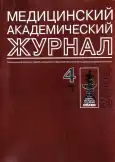Neuroimmunoendocrinological mechanisms of thymocytes proliferative activity regulation in postnatal ontogenesis
- Authors: Kvetnoy I.M.1,2, Yuzhakov V.V.3, Polyakova V.O.2, Yarilin A.A.4, Kurilets E.S.3, Mikhina L.N.3, Trofimov A.V.2, Konovalov S.S.2, Sharova N.I.4, Nikonova M.F.4
-
Affiliations:
- Ott Institute of Obstetrics and Gynecology
- Saint-Petersburg Institute of Bioregulation and Gerontology of the North-Western Branch of the Russian Academy of Medical Sciences
- Medical Radiological Research Center
- Institute of Immunology
- Issue: Vol 4, No 4 (2004)
- Pages: 52-58
- Section: Basis medicine
- Published: 29.11.2004
- URL: https://journals.eco-vector.com/MAJ/article/view/693982
- ID: 693982
Cite item
Abstract
The immunocytochemical study of the localization of hormones in thymic cells has been performed to clarify possible correlations of their expression with proliferative activity of thymocytes. We used commercial antibodies to serotonin, melatonin, somatostatin, glucagon, gastrin, beta-endorphin and histamine, and ABP or BSP kits for visualization of reaction. Computer image analysis was used to find correlations between hormone production and proliferative activity of thymocytes. Different subpopulations of thymocytes are able to produce hormones: precursors of T-lymphocytes (CD4¯CD8¯) contain serotonin and melatonin, immature cortical cells (CD4+CD8+) produce only serotonin, mature medullar cells (CD4+CD8¯) show immunoreactivity to serotonin, melatonin, beta-endorphin and histamine. The expression of serotonin, somatostatin and gastrin is localized in thymic epithelial cells, formating Gassal’s bodies. Proliferative activity of thymocytes depends from the expression of serotonin and somatostatin in thymic cells. The data received testify the expression of different hormones in human thymic cells and showing by this fact high endocrine activity of thymus. The presence of correlations between hormonal expression and cell proliferative activity could be considered as the bright illustration of important role of neuroimmunoendocrine mechanisms in the paracrine regulation of thymic functions.
About the authors
I. M. Kvetnoy
Ott Institute of Obstetrics and Gynecology; Saint-Petersburg Institute of Bioregulation and Gerontology of the North-Western Branch of the Russian Academy of Medical Sciences
Author for correspondence.
Email: shabanov@mail.rcom.ru
Russian Federation, Saint-Petersburg, 199034; Saint-Petersburg, 197110
V. V. Yuzhakov
Medical Radiological Research Center
Email: shabanov@mail.rcom.ru
Russian Federation, Obninsk, 249030
V. O. Polyakova
Saint-Petersburg Institute of Bioregulation and Gerontology of the North-Western Branch of the Russian Academy of Medical Sciences
Email: shabanov@mail.rcom.ru
Russian Federation, Saint-Petersburg, 197110
A. A. Yarilin
Institute of Immunology
Email: shabanov@mail.rcom.ru
Russian Federation, Moscow, 115478
E. S. Kurilets
Medical Radiological Research Center
Email: shabanov@mail.rcom.ru
Russian Federation, Obninsk, 249030
L. N. Mikhina
Medical Radiological Research Center
Email: shabanov@mail.rcom.ru
Russian Federation, Obninsk, 249030
A. V. Trofimov
Saint-Petersburg Institute of Bioregulation and Gerontology of the North-Western Branch of the Russian Academy of Medical Sciences
Email: shabanov@mail.rcom.ru
Russian Federation, Saint-Petersburg, 197110
S. S. Konovalov
Saint-Petersburg Institute of Bioregulation and Gerontology of the North-Western Branch of the Russian Academy of Medical Sciences
Email: shabanov@mail.rcom.ru
Russian Federation, Saint-Petersburg, 197110
N. I. Sharova
Institute of Immunology
Email: shabanov@mail.rcom.ru
Russian Federation, Moscow, 115478
M. F. Nikonova
Institute of Immunology
Email: shabanov@mail.rcom.ru
Russian Federation, Moscow, 115478
References
- Акмаев И. Г., Гриневич В. В. От нейроэндокринологии к нейроиммуноэндокринологии // Бюл. экспер. биол. 2001. Т. 131. № 1. С. 22—32.
- Ярилин А. А. Основы иммунологии. М.: Медицина, 1999. 608 с.
- Besedovsky H. O., del Rey A. Immunoneuroendocrine interactions: facts and hypotheses // Endocrine Rev. 1996. Vol. 17. № 1. P. 64—102.
- Carr D. J., Blalock J. E. «Classical» neuroendocrine peptide hormones produced by cells of the immune system // Brain Behav. Immun. 1988. Vol. 2. № 4. P. 328-334.
- Carr D. J., Weigent D. A., Blalock J. E. Hormones common to the neuroendocrine and immune systems // Drug. Des. Deliv. 1989. Vol. 4. № 3. P. 187-195.
- Goya R. G., Bolognani F. Homeostasis, thymic hormones and aging // Gerontology. 1999. Vol. 45. № 3. P. 174-178.
- Hishima T., Fukayama M., Hyashi Y., Fujii T., Arai K., Shiozawa Y., Funata N., Koike M. Neuroendocrine differentiation in thymic epithelial tumors with special referebce to thymic carcinoma and atypical thymoma // Hum. Pathol. 1998. Vol. 29. № 4. P. 330-308.
- Kubo Y., Nakana K. Regulation of histamine synthesis in mouse CD4⁺ and CD8⁺ T lymphocytes // Inflamm. Res. 1999. Vol. 48. № 3. P. 149-153.
- Kvetnoy I. M. Neuroimmunoendocrinology: where is the field of study // Neuroendocr. Lett. 2002. Vol. 23. № 2. P. 119-120.
- Zwadlo-Klarwasser G., Braam U., Muhl-Ziirbes R, Schmutzler W. Macrophages and lymphocytes: alternative sources of histamine // Agents Actions. 1994. Vol. 41. P. 99-100.
Supplementary files






